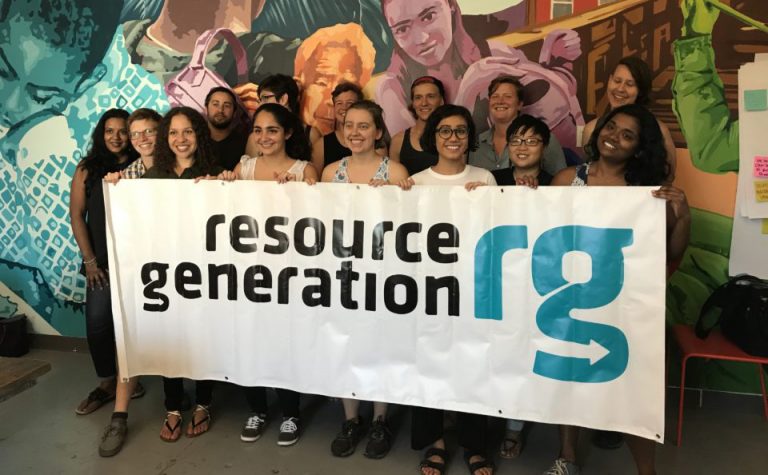Nimble formations that build power: panel recap
Reposted from Ari Sahagun’s blog.
I just got back from an amazing discussion: Organization 2.0: Empowering our Understanding of Nimble Formations that Build Power hosted by the Bay Area Justice Funders Network. It was a rich and generative space to think about organizations, movements and networks.
I heard about it as a local chapter leader of Resource Generation, and I attended this event to learn more about the shift from organization-centered thinking to movement and network paradigms. It’s a new way of looking at the nonprofit sector and, more broadly, social justice movements. What follows is a synthesis of what I heard and some of my thoughts from being in the room with a bunch of people thinking about a formative topic – a major transition in the field of social justice.
To give you a snapshot of how I understood who was in the room, check out this networkmap (so meta!). Panelists and conveners are red nodes.
This is limited based on my brief glimpse, and if you’d like me to add you, let me know.
From the perspective of shifting from organization-centered thinking to network- and movement-level thinking, here are 5 key points that speak to the complexity of networks.
1)Innovation requires failure which requires vulnerability.
Metamorphosis is awkward! If you don’t believe me just think about puberty. Restraining our need to appear perfect, we should embrace this awkwardness. Or, that’s the advice of the panelists. Much easier said than done! This was especially salient in a room full of women who are repeatedly targeted to not only appear flawless but also look good while we change the world.
Failure is inherent in innovation, and to fail well, you have to be vulnerable. A lot of people are afraid to look at this — with good cause — but it’s a practice that we can adopt and grow more familiar with. Oh and with these added challenges, there will come frustration in not knowing the clear path forward, but this is part of the journey, too.
2) Specific, fertile conditions support emergence.
Emergence of new ideas is the process and location from which innovation occurs. To support this:
- Create safe spaces to talk about half-baked ideas, challenges, and failures
- Find partners who are ready to move now and talk afterwards
- Embrace active learning – do more than just listen
- Build in time to think about next steps, strategy, vision
- Don’t attach any strings to these spaces
- Support spots that look “messy”
3) Organizational culture needs to shift.
Most organizations are resistant to change — after all, if it’s not broke, don’t fix it! In order to get at this vulnerability and make space for half-baked ideas to emerge, of which only some will be called innovation (and that’s only in hindsight) organizations will have to change.
Additionally, bringing a perspective of abundance, rather than scarcity is helpful. If we think of a fertile, vibrant ecosystem of ideas, rather than a harsh reality where only one idea can win, it can shift perspectives and support radical growth. Rather than focusing on specific outcomes, refocus to the larger vision. The idea of creating a network full of leadership rather than one of followers also lends itself to an abundance perspective.
4) “Impact happens at the speed of trust.”
This great sound bite speaks to the necessity of building relationships and trust in social change. To build long-term, lasting change and the power that is inherent, we’ll need to do more than get Facebook likes.
5) Learn to recognize invisibilized leadership.
Network leadership is usually less visible. Why is this? It wasn’t a coincidence that this discussion was happening in a room full of all women (except one man) and lead by women of color.
Our current definitions of leadership are generally in line with gender definitions (after all we live in a patriarchy), so we tend to recognize men as the “leaders,” “pioneers,” and “innovators.” Have you ever seen a widely read book on entrepreneurship written by women? (Better yet, a woman of color??) If so, tweet it to me!
Rather than saying “network leadership is not usually visible,” I wish we could come out and say that our current, widely-held, oft-strived-for models of leadership are sexist! So I see this as a recognition of women’s work, our leadership, and our innovation, and things will have to shift at a larger scale to be able to elevate these things.
6) Networks are complex! Here are some useful metaphors:
In understanding new and complex ideas, metaphors are super useful. I was also paying attention to how panelists and people at the event were talking about the work itself. Here are a few metaphors I found helpful in relating new complexity to ideas we already understand.
- connective tissue
- understanding the ecosystem
- key differences between networks and movements
- from organization 1.0 to 2.0
- from philanthropy 1.0 to 2.0
In a new, rich, generative space often there are more questions brought up than can be answered at the time. Here are a few outstanding and useful ones:
- How do you evaluate networks?
- What funding best supports networks?
- How do you support networks that foster emergence?
- What are the language differences between movement people and network people?
- What else supports networks besides facilitation?
- How do you implement innovation that happens in a network within an organization? Or, how do you “leverage innovation”?
- How to create space for innovation?
Also the hashtag #org2.0 collected some related thoughts: Tweets about “#org2”


